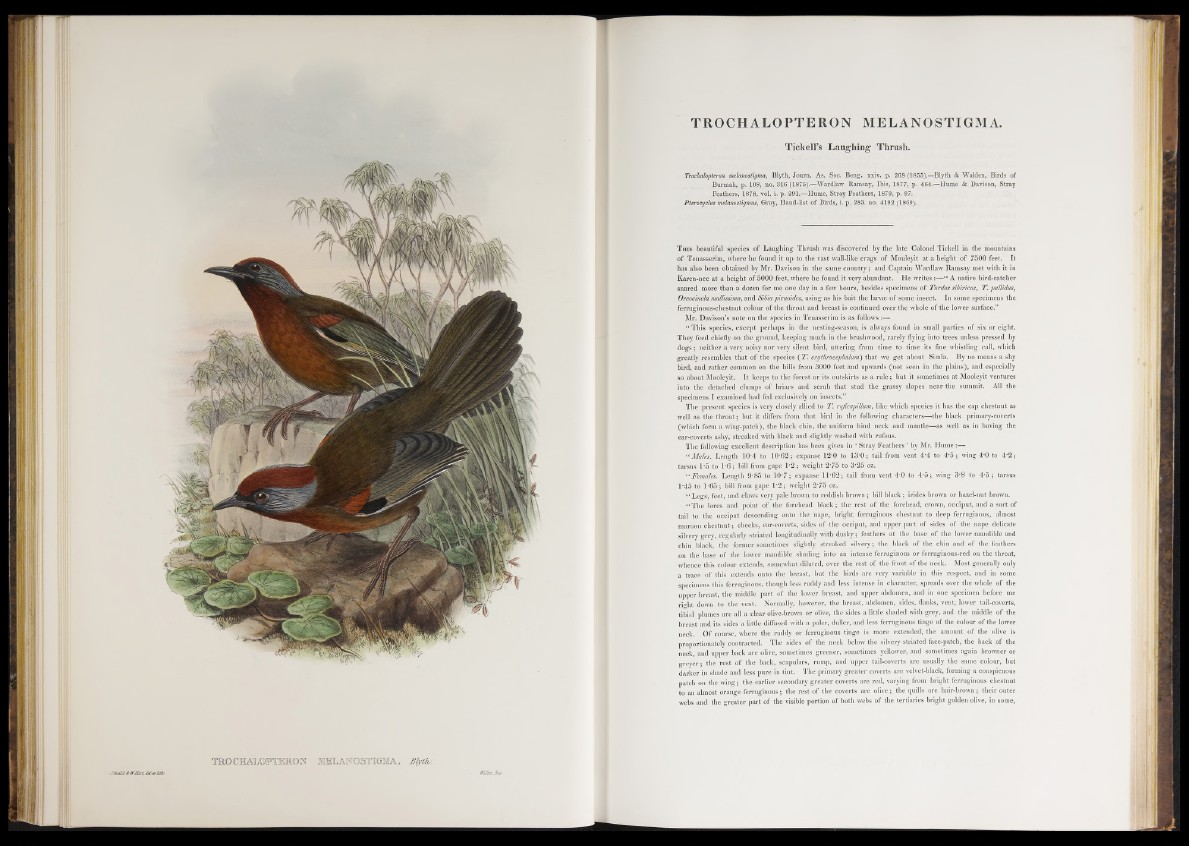
J&xH£’JrWjSar% ¿Ut'cC'hfll'-
TOOCHALOPTERON JffiEtAN OSTIGMA, Blytfu.
TROCHALOPTERON MELANOSTIGMA.
Tickell’s Laughing' Thrush.
Trochdlopteron melanostigma, Blyth, Journ, As. Soc. Beng. xxiv. p. 268 (1865).—Blyth & Walden, Birds of
Burmah, p. 108, no. 316 (1875).—Wardlaw Ramsay, Ibis, 1877, p. 464.—Hume & Davison, Stray
Feathers, 1878, vol. i. p. 291.—Hume, Stray Feathers, 1879, p. 97.
Pterocyclus melanostigmus, Gray, Hand-list of Birds, i. p. 283. no. 4192 (1869).
T h is beautiful species of Laughing Thrush was discovered by the late Colonel Tickell in the mountains
o f Tenasserim, where he found it up to the vast wall-like crags o f Mouleyit at a height of 7500 feet. It
has also been obtained by Mr. Davison in the same country; and Captain Wardlaw Ramsay met with it in
Karen-nee at a height of 5000 feet, where he found it very abundant. He writes:—“ A native bird-catcher
snared more than a dozen for me one day in a few hours, besides specimens of Tardus sibiricus, T. pallidus,
Oreocincla mollissima, and Sibia picaoides, using as his bait the lam e of some insect. In some specimens the
ferruginous-chestnut colour o f the throat and breast is continued over the whole of the lower surface.”
Mr. Davison’s note on the species in Tenasserim is as follows:—
“ This species, except perhaps in the nesting-season, is always found in small parties of six or eight.
They feed chiefly on the ground, keeping much in the brushwood, rarely flying into trees unless pressed by
dogs; neither a very noisy nor very silent bird, uttering from time to time its fine whistling call, which
greatly resembles that of the species (T . erythrocephalum) that we get about Simla. By no means a shy
bird, and rather common on the hills from 3000 feet and upwards (not seen in the plains), and especially
so about Mooleyit. It keeps to the forest or its outskirts as a ru le ; but it sometimes at Mooleyit ventures
into the detached clumps of briars and scrub that stud the grassy slopes near the summit. All the
specimens I examined had fed exclusively on insects.”
The present species is very closely allied to T. ruficapillum, like which species it has the cap chestnut as
well as the th ro a t; but it differs from that bird in the following characters—the black primary-coverts
(which form a wing-patch), the black chin, the uniform hind neck and mantle—as well as in having the
ear-coverts ashy, streaked with black and slightly washed with rufous.
The following excellent description has been given in ‘ Stray Feathers ’ by Mr. Hum e:—
“ Males. Length 10‘4 to 10-6 2 ; expanse 12’0 to 13’0 ; tail from vent 4 ’4 to 4*5; wing 4 '0 to 4*2;
tarsus 1*5 to 1*6; bill from gape 1*2; weight 2 75 to 3 -25 oz.
“ Females. Length 9 -85 to 1 0 7 ; expanse 11*62; tail from vent 4-0 to 4*5; wing 3*8 to 4*5; tarsus
1‘45 to 1*65; bill from gape 1*2; weight 2*75 oz.
“ Legs, feet, and claws very pale brown to reddish brown ; bill black; irides brown or hazel-nut brown.
“ The lores and point of the forehead black; the rest of the forehead, crown, occiput, and a sort of
tail to the occiput descending onto the nape, bright ferruginous chestnut to deep ferruginous, almost
maroon chestnut; cheeks, ear-coverts, sides of the occiput, and upper p art of sides of the nape delicate
silvery grey, regularly striated longitudinally with dusky; feathers at the base o f the lower mandible and
chin black, the former sometimes slightly streaked silvery; the black of the chin and of the feathers
on the base of the lower mandible shading into an intense ferruginous or ferruginous-red on the throat,
whence this colour extends, somewhat diluted, over the rest of the front of the neck. Most generally only
a trace o f this extends onto the breast, but the birds are very variable in this respect, and in some
specimens this ferruginous, though less ruddy and less intense in character, spreads over the whole o f the
upper breast, the middle part of the lower breast, and upper abdomen, and in one specimen before me
right down to the vent. Normally, however, the breast, abdomen, sides, flanks, vent, lower tail-coverts,
tibial plumes are all a clear olive-brown or olive, the sides a little shaded with grey, and the middle of the
breast and its sides a little diffused with a paler, duller, and less ferruginous tinge of the colour o f the lower
neck. Of course, where the ruddy or ferruginous tinge is more extended, the amount of the olive is
proportionately contracted. The sides o f the neck below the silvery striated face-patch, the back of the
neck, and upper back are olive, sometimes greener, sometimes yellower, and sometimes again browner or
greyer; the rest of the back, scapulars, rump, and upper tail-coverts are usually the same colour, but
darker in shade and less pure in tint. The primary greater coverts are velvet-black, forming a conspicuous
patch on the wing; the earlier secondary greater coverts are red, varying from bright ferruginous chestnut
to an almost orange ferruginous; the rest of the coverts are olive; the quills are hair-brown; their outer
webs and the greater part of the visible portion of both webs of the tertiaries bright golden olive, in some,